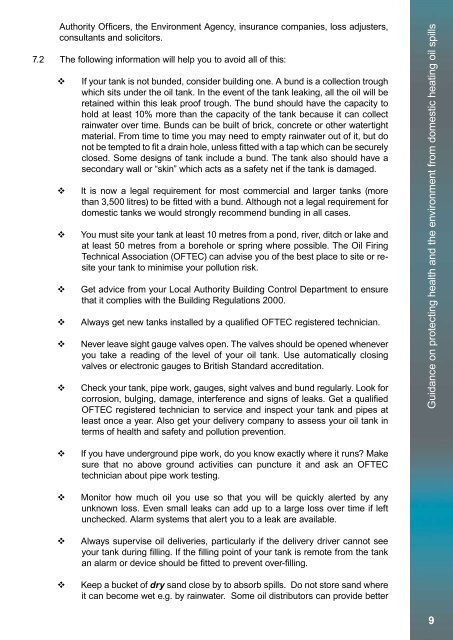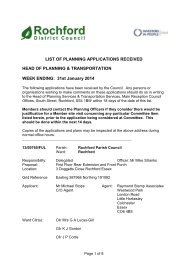Domestic Heating Oil Tank Guidance - Pembrokeshire County Council
Domestic Heating Oil Tank Guidance - Pembrokeshire County Council
Domestic Heating Oil Tank Guidance - Pembrokeshire County Council
You also want an ePaper? Increase the reach of your titles
YUMPU automatically turns print PDFs into web optimized ePapers that Google loves.
Authority Officers, the Environment Agency, insurance companies, loss adjusters,<br />
consultants and solicitors.<br />
7.2 The following information will help you to avoid all of this:<br />
If your tank is not bunded, consider building one. A bund is a collection trough<br />
which sits under the oil tank. In the event of the tank leaking, all the oil will be<br />
retained within this leak proof trough. The bund should have the capacity to<br />
hold at least 10% more than the capacity of the tank because it can collect<br />
rainwater over time. Bunds can be built of brick, concrete or other watertight<br />
material. From time to time you may need to empty rainwater out of it, but do<br />
not be tempted to fit a drain hole, unless fitted with a tap which can be securely<br />
closed. Some designs of tank include a bund. The tank also should have a<br />
secondary wall or “skin” which acts as a safety net if the tank is damaged.<br />
It is now a legal requirement for most commercial and larger tanks (more<br />
than 3,500 litres) to be fitted with a bund. Although not a legal requirement for<br />
domestic tanks we would strongly recommend bunding in all cases.<br />
You must site your tank at least 10 metres from a pond, river, ditch or lake and<br />
at least 50 metres from a borehole or spring where possible. The <strong>Oil</strong> Firing<br />
Technical Association (OFTEC) can advise you of the best place to site or resite<br />
your tank to minimise your pollution risk.<br />
Get advice from your Local Authority Building Control Department to ensure<br />
that it complies with the Building Regulations 2000.<br />
Always get new tanks installed by a qualified OFTEC registered technician.<br />
Never leave sight gauge valves open. The valves should be opened whenever<br />
you take a reading of the level of your oil tank. Use automatically closing<br />
valves or electronic gauges to British Standard accreditation.<br />
Check your tank, pipe work, gauges, sight valves and bund regularly. Look for<br />
corrosion, bulging, damage, interference and signs of leaks. Get a qualified<br />
OFTEC registered technician to service and inspect your tank and pipes at<br />
least once a year. Also get your delivery company to assess your oil tank in<br />
terms of health and safety and pollution prevention.<br />
If you have underground pipe work, do you know exactly where it runs? Make<br />
sure that no above ground activities can puncture it and ask an OFTEC<br />
technician about pipe work testing.<br />
Monitor how much oil you use so that you will be quickly alerted by any<br />
unknown loss. Even small leaks can add up to a large loss over time if left<br />
unchecked. Alarm systems that alert you to a leak are available.<br />
Always supervise oil deliveries, particularly if the delivery driver cannot see<br />
your tank during filling. If the filling point of your tank is remote from the tank<br />
an alarm or device should be fitted to prevent over-filling.<br />
Keep a bucket of dry sand close by to absorb spills. Do not store sand where<br />
it can become wet e.g. by rainwater. Some oil distributors can provide better<br />
<strong>Guidance</strong> on protecting health and the environment from domestic heating oil spills<br />
9



